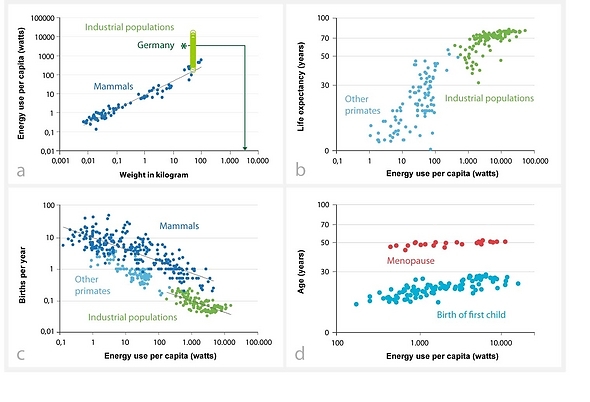July 05, 2012 | News | New Publication
What the electric meter tells us about the birthrate

Humans satisfy their appetite for energy through electrical outlets and other industrial sources. This enormous energy usage could explain the low birth rates seen in highly developed countries. © photocase: froodmat / photocase.com
If a German woman were to consume in the form of food the amount of energy she uses, and were to follow the fertility patterns seen in other species, she would weigh as much as two elephants, and would continue to bear children up to the age of 70. This is because, generally, the more energy an organism uses, the bigger it is, the longer it lives, and the later it reproduces. But is this true of humans? After all, humans satisfy their appetite for energy through electrical outlets and other industrial sources.
(The following text is based on the original article Industrial energy use and the human life history by MPIDR researcher Oskar Burger and has with minor changes also been published in the issue 02/2012 of the demographic quarterly Demografische Forschung aus Erster Hand.)
Humans need to eat around 2,000 calories per day, but the average person in industrial nations burns more than 32,000 calories a day. In wealthy industrial nations like Germany, the average energy consumption of an individual is 110,000 calories, which is still only half of the U.S. value. Because he only eats a small portion of the energy he uses, this level of energy consumption has little effect on the individual’s weight. It does, however, influence his demographic traits, such as lifespan and birth rate, Oskar Burger of the Max Planck Institute for Demographic Research has found in a new study. And this enormous energy usage could even explain the low birth rates seen in highly developed countries, according to the author and his collaborators.
For almost all animals, body size determines energy use because it determines their metabolic rates, and both body size and energy use are highly correlated with most demographic traits: for example, a giraffe that weighs about 13 times as much as a human burns over 24,000 calories a day, has around 0.6 calves a year, and has a maximum life expectancy of 36 years. A tiny spine mouse, by contrast, needs to consume only around 19 calories a day to maintain its body weight of 45 grams. The mouse has a maximum lifespan of only five years, but gives birth to more than eight offspring a year in that time. These values for the giraffe and the mouse obey so-called “allometric” relationships. The giraffe is 18,000 times heavier than the mouse; the life expectancies and birth rates of these animals change predictably as a function of this change in mass, but they change in smaller steps. The same basic relationship holds across all mammal species, from the smallest to the largest (see Fig. 1b and 1c).

Fig. 1a: The sizes of mammals are shown in relationship to their metabolic rates. In industrialized countries, the per capita consumption of energy varies considerably, but it is much higher than expected. Human weight is set here at 50 kilograms. 1b: Life expectancy among humans rises along with energy consumption, but the rate of increase declines as the energy level rises. 1c: Birth rates decline with rising energy use roughly equally among humans and other mammals. 1d: With a rise in the per capita energy consumption of a country, the gap between the birth of the first child and the onset of menopause decreases. Source: see www.demografische-forschung.org/material © MPIDR
Humans are the exception that proves this rule. If a German man were to actually consume all of the energy he uses in the form of food, he would weigh 6,435 kilograms (see Fig. 1a). But the ability of humans to use non-food energy sources has altered this biologically fundamental relationship between body weight and energy use. There is, however, a precise correlation between other demographic traits and energy consumption: a hypothetical female primate that ate 110,000 calories a day would not only weigh as much as two elephants; she would also have a maximal life expectancy of 112 years, and would bear her first child at the age of 27.
These values fit surprisingly well with the data for average Germans. A comparison between countries with different energy levels also shows that the more watts a country uses, the higher the life expectancy is (see Fig. 1b), the later children are born, and the lower the birth rates (see Fig. 1c) and the mortality rates of children under age five are.
To prevent a population from shrinking as a result of declining birth rates, the reproductive period should grow in line with energy consumption. But whereas the elephantine creature with the energy consumption of a mean German woman could still have children at the age of 70, German women typically stop having babies by the age of 42. Oskar Burger sees a possible explanation for the low birth rates in many industrial nations in this curtailment of the reproductive lifespan (see Fig. 1d), as almost all the populations of countries that use a lot of energy tend to have below-replacement fertility.
More Information
-
Burger, O. J. DeLong, M. Hamilton: Industrial energy use and the human life history. Scientific Reports 1(2011)56.
-
www.demografische-forschung.org - Website of the demographic quarterly (german language only)